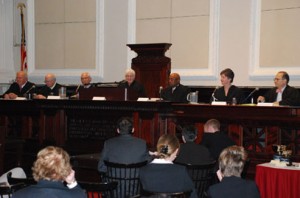In this blog post, Isha Singh, a student pursuing her LL.B (5h year) Hons. from Rajiv Gandhi National University of Law, Patiala, Punjab and a Diploma in Entrepreneurship Administration and Business Laws from NUJS, Kolkata, details the need for social security and the vision of national security by the 2nd National Commission on Labour.
Social Security-Meaning
The need for Social Security has been due to the inherent insecurity in the humans due to exposure to various kinds of risks and dangers. Such insecurities arise due to the fear of losing jobs, the fear of having enough to eat in the future or not and having socially empowering schemes for themselves or not.
“Human security can be said to have two main aspects. It means, first, safety from such chronic threats as hunger, disease and repression. And second, it means protection from sudden and hurtful disruptions in the patterns of daily life – whether in homes, in jobs or in communities. Such threats can exist at all levels of national income and development.”[1]
Social Security-Definition
The term “social security” invites ambiguity because it has not clearly been defined anywhere. However, there are two schools of thought- one is that of ILO, that restricts it only to the protection of income against loss, and the other is a holistic concept that entails the protection of all interests of the human life.[2]
The approach to social security can be different for different people. For instance, Lord Beveridge (1942) listed eight kinds of primary conditions which demand social security, viz, Unemployment, disability, loss of livelihood, retirement, marriage expenses, funeral expenses, physical disease or incapacity, childhood allowances.[3]
2nd National Commission on Labour
Introduction
This report was submitted in the year 2002. The Chapter VIII of the report addressed the issue of Social Security. However, the report was a critique of the existing labour law regime and suggested reforms in the organised sector, it also supplemented the introduction of reforms in the nongovernmental sector as the Government Sector employees were covered under the schemes that were framed as under Article 309 of the Indian Constitution read with the recommendations of the Pay Commissions.
The report raised a concern that the legal regime in India pertaining to social security is on the lines of the recommendations of the ILO, though all such Conventions haven’t been ratified by India as yet. The Study Group on Social Security, formed as a part of the Report-building process remarked that although it might not be possible to ratify all the conventions immediately, their eventual accession is desirable by timely amendments in the laws and policies, starting with the Minimum Standards Convention.
Reason for the need of the Commission
The inadequacy of the Labour law regime in India to address the social security benefits for the unorganised sector coupled with the laxity in the implementation of the current benefits for the Governmental sectors gave rise to the Commission in 2002 and its report submission giving out suggestions and recommendations to remedy the current scenario.
National Social Security –A vision of the Commission
Due to the inadequacy of the labour law legislations to address the issue of social security among employees, the need for the report was felt. Therefore, the Commission came out with the following suggestions and recommendations:
- The Commission was of the opinion that a National Policy on Social Security be formulated and a Nation-wide plan, or scheme be structured to achieved the objectives set out in the Indian Constitution.[4]
- Considering the proposals put forward by various committees like the Committee on India Labour Code (1994), The Ninth Plan Working Group on Labour Policy; the commission recommended the constitution of a high-powered National Social Security Authority under the Chairmanship of the PM of India. The function of the Authority would be the reinforcement of the National Security policy at the federal and the state level.[5]

- At the administrative level, it is imperative to an exclusive Ministry/Department dealing with various aspects of the subject of social security. It could be an entirely separate Ministry of Social Security or a Department of Social Security within either the Ministry of Labour or the Ministry of Social Justice.[6]
- Functional integration of Social Security programmes could be attempted by establishing a Centre Social Security Board having separate division dealing with:
- Medical benefits
- Sickness, maternity and employment injury benefits.
- Old-age, invalidity, survivors benefits including gratuity and funeral expenses.
- Unemployment insurance and other related services.
- Common services, namely, registration, a collection of contributions, inspections, penalties, etc.[7]
- A similar mechanism of Social Security Board be replicated at the State level and corresponding committees at Area and District levels so that this service should be decentralised and reach out to maximum beneficiaries as possible, and it is tripartite or multi-partite involving workers, other stakeholders, too. For the same purpose, the committees will have the below-mentioned functions:
- Identification of the beneficiaries and the issue of identity cards to them.
- A collection of contributions.
- Dispensing the benefits.
- Maintenance of records.[8]
- A compassionate Public Relations Team needs to be set in place to counter the hesitation of the poor and illiterate people shying away from availing the benefits of the social security regime. The prime function of the team would be to impart basic knowledge as to the schemes.[9]
- Since poverty is the root cause of social insecurity in India due to the deprivation of productive and remunerative income for the people, therefore, State must assume responsibility to take care of contingencies that create social insecurity and provide the people with a stable and peaceful income opportunity.[10]
- Priority must be given to old, infirm and young people who are destitute and constitute a liability on the state, by providing them with social assistance programmes.[11]

- Special care needs to be extended to women, children and old people who need to be given maternity benefit, security against widowhood and desertion; care and nutrition; and security against unemployment in old age and pension benefits respectively.[12]
- The Social Security System envisaged by the Commission broadly entailed 4 tiers, namely:
- Social assistance programmes financed wholly by taxes and from the exchequer.
- Partly contributory schemes which are partly subsidised by the State
- Wholly contributory social insurance schemes,
- Voluntary Schemes.[13]
- Lastly, the Commission recommended that the social security policy/plan for India must be outlined on the following principles:
- Classification
- Participation
- Equity and Efficiency
- Occupation-specific/ Area-specific/ Need-specific
- Gender Adequacy
- Unified Administration[14]
Recommendations for the unorganised Sector
The commission clarified that the unorganised sector included:
- The Self-employed group;
- Those employed in small establishments outside the purview of current social security regime;
- Those employed on a casual or intermittent basis without any security of income.[15]
To begin with, the Commission proposed that once the social security programme built for the organised sector is launched in full-swing, the people under the unorganised sector would be slowly and progressively roped in. However, pending such inclusion, there at least must be the successful implementation of the following measures:
- Welfare funds must be appropriately set up for each of the major employments, such as rickshaw pullers, agriculture, beedi industry, fishery, etc.
- Moreover, such Welfare funds need to be contributory, such that large contributions are warranted from the employers because as it is, the contributions made by the workers would be small and insignificant owing to their unstable income.[16]
- Subsidised insurance schemes must be made more popular among such workers, covering insurance for major life hazards and risks including health, life, accident, unemployment, paired with a uniform rate of subsidy.[17]
- Unorganised workers may be mobilised and organised into:
- Self-Help Groups
- Local Workers Economic Organisation
- District Level Cooperatives including Milk Cooperatives
- Mahila Mandals/ Yuvak Mandals, etc.[18]

- To cover pensions and other rateable benefits like maternity or old age benefits, either the existing ESI and EPF/ EPS schemes may be suitably amended to provide such protection against a composite contribution, or separate insurance schemes may, as appropriate, be devised for the self-employed on an occupational or area basis.[19]
- National Old Age Pension scheme may be redesigned and drawn up, just like the National Maternity Benefit Scheme for the unorganised sector. Moreover, a National Housing Scheme and a National Cloth Supply Scheme may be formulated for the distribution of houses and cloth to people at a subsidised rate.[20]
References:
[1] Retrieved from <http://www.prsindia.org/uploads/media/1237548159/NLCII-report.pdf> on 31st October 2016 at 13:01 hrs.
[2] Report of the 2nd National Commission on Labour, 2002, page 800.
[3] Id, p 804.
[4] Id, p 911.
[5] Id, p 912.
[6] Id, p 913.
[7] Id, p 913.
[8] Id, p 914.
[9] Id, p 921.
[10] Id, p 923.
[11] Id, p 925.
[12] Id, p 926.
[13] Id, p 926.
[14] Id, p 926.
[15] Id, p 933
[16] Id, p 934
[17] Id, p 935
[18] Id, p 937.
[19] Id, p 938.
[20] Id, p 942.












